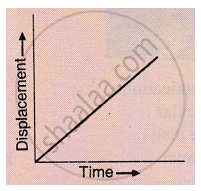Advertisements
Advertisements
Question
A car starting from rest acquires a velocity 180m s-1 in 0.05 h. Find the acceleration.
Solution
Here, final velocity = 180 m/s
Initial velocity = 0 m/s
Time taken = 0.05 h or 180 s
Acceleration = (Final Velocity - Initial Velocity)/time
= (180-0)/180 m s-2
= 1 m s-2
APPEARS IN
RELATED QUESTIONS
What conclusion can you draw about the velocity of a body from the displacement-time graph shown below :

Name the quantity which is measured by the area occupied under the velocity-time graph.
A freely falling object travels 4.9 m in 1st second, 14.7 m in 2 nd second, 24.5 m in 3rd second, and so on. This data shows that the motion of a freely falling object is a case of :
If a stone and a pencil are dropped simultaneously in vacuum from the top of a tower, then which of the two will reach the ground first? Give reason.
A body starts from rest and acquires a velocity 10 m s-1 in 2 s. Find the acceleration.
A bicycle initially moving with a velocity 5.0 m s-1 accelerates for 5 s at a rate of 2 m s-2. What will be its final velocity?
Multiple choice Question. Select the correct option.
A body dropped from the top of a tower reaches the ground in 4s. Height of the tower is
Multiple choice Question. Select the correct option.
The speed of a car reduces from 15 m/s to 5 m/s over a displacement of 10 m. The uniform acceleration of the car is :
How can you find the following?
Velocity from acceleration – time graph.
Draw a velocity versus time graph of a stone thrown vertically upwards and then coming downwards after attaining the maximum height.
